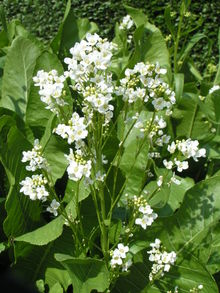Horseradish

Horseradish (Armoracia rusticana, syn. Cochlearia armoracia) is a perennial plant of the family Brassicaceae (which also includes mustard, wasabi, broccoli, cabbage, and radish). It is a root vegetable, cultivated and used worldwide as a spice and as a condiment. The species is probably native to southeastern Europe and western Asia.
Horseradish grows up to 1.5 meters (5 feet) tall, with hairless bright green unlobed leaves up to 1 m (3 ft 3 in) long that may be mistaken for docks (Rumex).[2]:423 It is cultivated primarily for its large, white, tapered root.[3][4][5][6] The white four-petalled flowers are scented and are borne in dense panicles.[2] Established plants may form extensive patches[2] and may become invasive unless carefully managed.[7]
Intact horseradish root has little aroma. When cut or grated, enzymes from within the plant cells digest sinigrin (a glucosinolate) to produce allyl isothiocyanate (mustard oil), which irritates the mucous membranes of the sinuses and eyes. Once exposed to air or heat, horseradish loses its pungency, darkens in color, and develops a bitter flavor.
